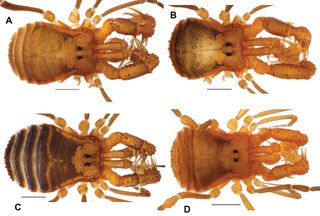
Scientists have unearthed a monstrous new arachnid lurking in the woods of southwest Oregon — and it's a beast.
The new daddy longlegs species, dubbed Cryptomaster behemoth, towers over other creatures of its kind. And like its cousin, the equally elusive Cryptomaster leviathan, the new species is incredibly difficult to find, because it hides out beneath the logs and leafy debris that blanket the forest floor.
The Cryptomaster leviathan was discovered in 1969 at one location in the coastal town of Gold Beach, Oregon. The mysterious creature belonged to one of the most diverse suborders, called Laniatores, which contains at least 4,100 species. (Daddy longlegs belong to the arachnid order commonly known as harvestmen, so-called because they often emerge during the fall months during the harvest.) [In Images: 4-Eyed Daddy Longlegs Helps Explain Arachnid Evolution]
Though the 0.15-inch-wide (4 millimeters) body of the creature is relatively small compared to that of tarantulas or other arachnids, the daddy longlegs towers over other creatures in its Laniatores suborder. As a result, its discoverers gave it the species name leviathan, after the serpentlike sea creature that prowls the deep in the Bible. The genus name Cryptomaster is a nod to the creature's elusive and reclusive nature.
For 40 years, little else was known about C. leviathan. But in recent years, researchers have found more of these elusive creatures at multiple locations, including some as far off as the Cascade Mountains in southwest Oregon.
That led James Starrett, an entomologist at San Diego State University, and his colleagues to suspect there may be other undiscovered species in the Cryptomaster genus. The researchers set out on an expedition to the region, on a hunt for new Cryptomaster species.
New monster lurking
Sign up for the Live Science daily newsletter now
Get the world’s most fascinating discoveries delivered straight to your inbox.
This hunt led them to the discovery of a completely new daddy longlegs species, also relatively huge, called Cryptomaster behemoth. (The behemoth, like the leviathan, is a biblical beast.) Both have the unusually short legs characteristic of arachnids of the Laniatores order.
One of the main differences between the two species is that C. leviathan sports two teensy, fully erect spines pointing upward on its penis. The purpose of those spines isn't clear.
Interestingly, both the C. leviathan and C. behemoth speciescome in two forms: a larger and a smaller one.
But exactly why remains a mystery.
"The basis for these two forms is unknown — the different forms can be found in both sexes, in both species and from the same localities. Additionally, the two forms are not genetically divergent," the researchers wrote in the paper, which was published online Jan. 20 in the journal Zookeys.
The team also extracted DNA from the legs of multiple animals from each species. Interestingly, the C. leviathan has relatively little genetic diversity, though the creature shows up in a wide range of habitats. By contrast, C. behemoth seems to have a more restricted range, yet has much more genetic diversity than does C. leviathan. The genetic analysis also revealed that the big and small versions of each species don't differ genetically, so some other factor must explain the size difference.
The new species reveal how much genetic diversity can be found within a relatively tiny area, the scientists wrote.
"This research highlights the importance of short-range endemic arachnids for understanding biodiversity, and further reveals mountainous southern Oregon as a hot spot for endemic animal species," the researchers wrote.
Editor's Note: This article was updated to correct James Starrett's affiliation; he is at San Diego State University, not at the University of California, Riverside as was stated.
Follow Tia Ghose on Twitterand Google+. Follow Live Science @livescience, Facebook & Google+. Original article on Live Science.

Tia is the managing editor and was previously a senior writer for Live Science. Her work has appeared in Scientific American, Wired.com and other outlets. She holds a master's degree in bioengineering from the University of Washington, a graduate certificate in science writing from UC Santa Cruz and a bachelor's degree in mechanical engineering from the University of Texas at Austin. Tia was part of a team at the Milwaukee Journal Sentinel that published the Empty Cradles series on preterm births, which won multiple awards, including the 2012 Casey Medal for Meritorious Journalism.
